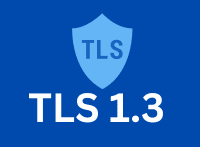What is TLS 1.3?
TLS 1.3, or Transport Layer Security version 1.3, is a cryptographic protocol created to provide secure communication over a network. It’s the latest version of TLS, which is the successor to SSL (Secure Sockets Layer). TLS Key Features include:
- Enhanced Security: TLS 1.3 has a streamlined handshake process compared to previous versions, which reduces the potential attack surface and simplifies the security model. All key exchanges in TLS 1.3 use ephemeral keys, which means that past communications remain secure even if a server’s private key becomes compromised in the future. Older, less secure cryptographic algorithms and features, such as RC4, SHA-1, and static RSA, are removed or deprecated in TLS 1.3.
- Performance Improvements: TLS 1.3 reduces the number of round-trips required to establish a secure connection. This results in a quicker handshake process, improving website and service load times. TLS 1.3 introduces a feature called 0-RTT (zero round-trip time) data, which allows data to be sent in the initial handshake message. This can speed up connections for clients that have connected to the server before; the downside to this is that it can lead to replay attacks.
- Privacy Enhancements: TLS 1.3 encrypts more of the handshake process compared to earlier versions, which helps protect against certain types of attacks and eavesdropping.
Transport Layer Security (TLS) VS Secure Sockets Layer (SSL)
TLS or Transport Layer Security and SSL or Secure Sockets Layer are cryptographic protocols created to secure communication over a network. While they serve similar purposes, TLS is the modern and more secure successor to SSL. Organizations should use the latest version of TLS to ensure the highest level of security for their communications.
SSL (Secure Sockets Layer)
SSL has three main versions: SSL 1.0 (never publicly released), SSL 2.0 (released in 1995), and SSL 3.0 (released in 1996). SSL 3.0 was a significant improvement over SSL 2.0 but is now considered outdated. SSL 2.0 and SSL 3.0 are no longer considered secure due to various vulnerabilities. They have been deprecated and replaced by TLS. SSL should no longer be used to secure communications due to vulnerabilities.
TLS (Transport Layer Security)
TLS evolved from SSL, with TLS 1.0 being the first version released in 1999. Subsequent versions include TLS 1.1 (2006), TLS 1.2 (2008), and TLS 1.3 (2018). Each version brought enhancements and improvements over its predecessors. TLS continues to be developed and refined to address emerging security threats and improve performance.
Now that you understand what TLS is let’s proceed with enabling TLS using IIS Crypto. Click here to download IIS Crypto. Download based on your preference. For this example, I will download the GUI version, as shown below.

Locate the application downloaded and double-click it to run the IIS Crypto application.

Click the accept button to accept the License Agreement.

In IIS Crypto, navigate to the Schannel tab. Here, you will see a list of available TLS versions for server and client protocols. Uncheck other protocols and check TLS 1.3 only for Server and Client to enable only TLS 1.3 and disable the older protocols. Check the Reboot box and click apply to apply and reboot.

The system will reboot. To confirm that the changes have taken effect, launch IIS Crypto and click on Schannel. See the screenshot below.

